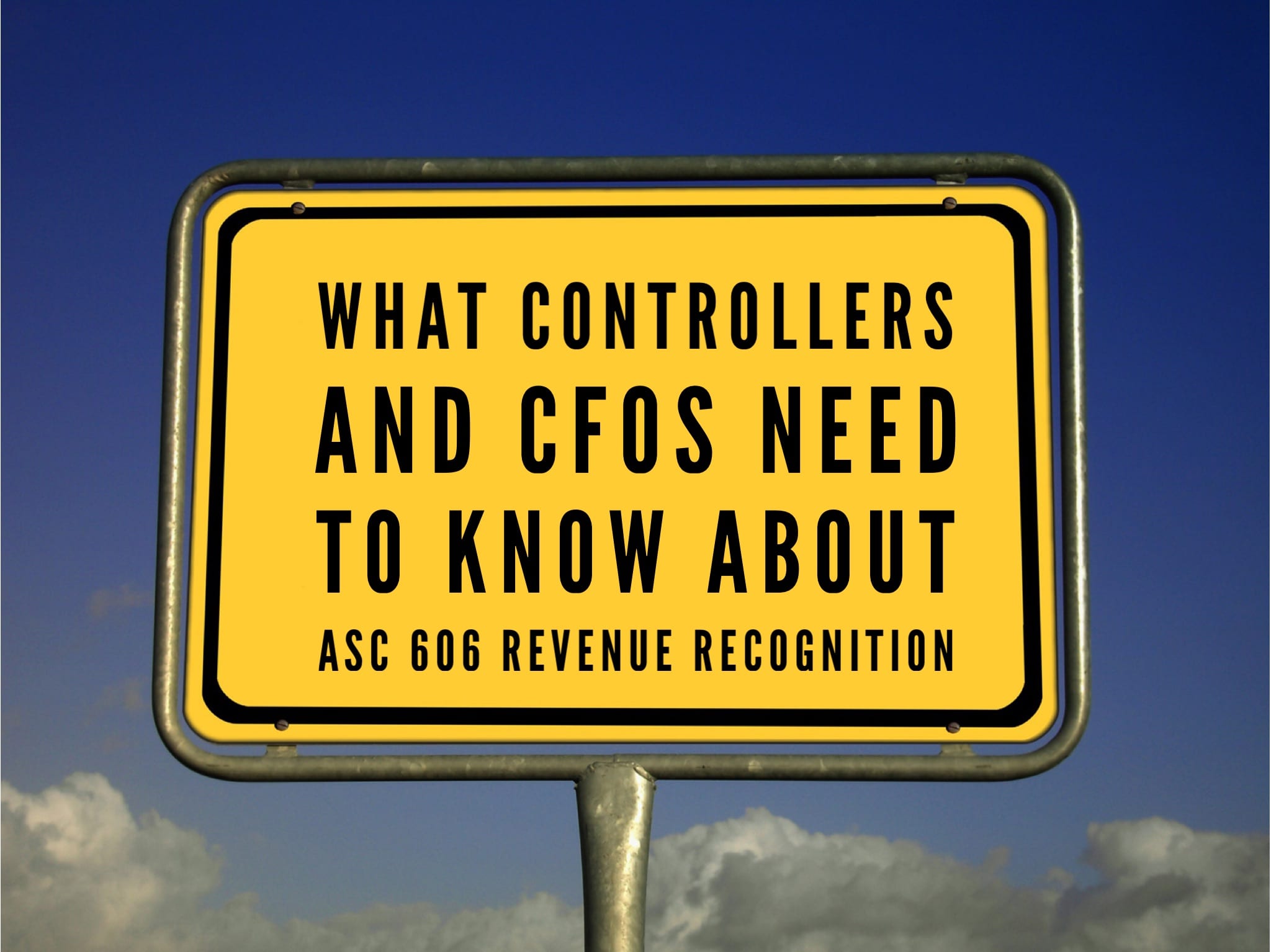
Blog -




Accounting
What Controllers and CFOs Need to Know About ASC 606
Ask any auditor what the toughest issue is for controllers and CFOs these days, and chances are it will be revenue recognition principles. As Jim Loughmiller, CPA and Co-Founder of ARC Consulting said, the intent of the new guidance is all about getting “the economics of the transaction to better match the accounting.” Understanding the theory is one thing, but making it work in your books is another.
I recently had a chat with Loughmiller and his colleague, Ryan Dillard, CPA, Director at ARC Consulting, to get their insights into the challenges for controllers and CFOs in implementing FASB’s latest standard for revenue recognition, ASC 606.
Their company has been helping companies navigate those changes, so they know a thing or two. ARC Consulting provides high level accounting, reporting and compliance support to public and private companies, primarily in the San Francisco Bay Area. Their services include GAAP implementation / analysis, audit facilitation, acquisition due diligence, SEC reporting and IPO readiness, among other specialized services.
The ASC 606 Experts at ARC Consulting
Jim Loughmiller, CPA
Co-Founder & Managing Director @ ARC Consulting
Jim has over 18 years of experience in accounting, auditing, consulting and business development. His experience covers all of the firms’ service offerings, as well as new accounting pronouncement implementation including the new revenue standard (ASC 606), complex technical accounting, audit preparation/facilitation, SEC reporting, due diligence, financing transactions and compliance activities.
Ryan Dillard, CPA
Director @ ARC Consulting
Ryan has over 13 years of experience in accounting, auditing, and consulting. His experience includes working on financing transactions, SEC reporting, research of complex accounting issues, initial public offerings, audit preparation/facilitation, external auditing and internal controls documentation and testing.
Like any significant change in accounting standards, Loughmiller said that the biggest challenge for controllers “is really just a lack of resources.” Besides learning the new standard “you still gotta do your day job,” said Loughmiller. “So I need to relearn everything that I did before regarding revenue recognition under a new lens, plus I also have to keep closing the books and issuing invoices and collecting cash and all of that other fun stuff.”
A (Simple?) 5-Step Process
In contrast to legacy GAAP, which had industry-specific rules to follow, ASC 606 is a principle-based approach to revenue recognition. In brief, the new guidance lays out a five-step process for recognizing revenue:
- Step 1: Identify the contract. What is it that you’re promising to do for the customer?
- Step 2: Identify the performance obligations. Break the contract into its separate components.
- Step 3: Determine the transaction price. What’s your best estimate of what you expect to receive from the customer?
- Step 4: Allocate the transaction price to the separate performance obligations.
- Step 5: Recognize the revenue over time or at a point in time.
Loughmiller went on to say that for software and SaaS companies implementing ASC 606 “the top line impact on their revenue may not be that significant,” but because the new guidance calls for deferral of costs, “there’s often a lot more impact on the bottom line from costs than from revenue.”
Under the old guidance, capitalizing direct and incremental costs to obtain a contract and amortizing them over the contract was optional. But under ASC 606, the incremental costs of obtaining contracts are now required to be capitalized. An incremental cost is “a cost that you wouldn’t have incurred had you not signed the deal,” explained Dillard.
This also means that those incremental costs may even extend up the chain of management beyond the original sales person, or down the chain to sales support, as they no longer have to be directly related to one specific contract. “We’re seeing other commission plans come into scope of being deferrable,” Dillard continued. This may include management bonuses or other incentive bonuses. “That’s having a much larger impact from a bottom line perspective, especially on our SaaS clients.”
Another big change from the old guidance is the amortization period to be used, also referred to as the period of benefit. Under the old guidance, if contract costs were amortized at all, it was generally over the contract period. But under ASC 606, contract costs are now required to be amortized over the period for which the asset is expected to contribute directly or indirectly to future cash flows and may include anticipated contract renewals. As Dillard said, “so we’re seeing even the companies that were deferring costs before, not only are they now probably going to defer more, but it likely will be amortized over a longer period of time as well.”
However, if commissions paid at contract renewal are similar to, or to use FASB’s terminology, “commensurate with,” the original commissions, then the amortization period is just the contractual period of the related contract.
SaaS contracts tend to be sticky, with some customers renewing for years or even decades, but it may not make sense to amortize the costs beyond the lifecycle of the technology. Five years down the road, the features and services may have little relationship to the original software in the contract. In Dillard’s experience, companies are tending to consider the original contract term plus one or two renewals, and also look at technology life to derive the proper period of benefit.
Tighten Up Those Records
This new principle-based approach to revenue recognition is simpler in some ways, but it’s a lot more complex in that there’s a lot of discretion involved, and with much more detail that needs to be tracked – the commissions, and products and services. So record keeping has to be a lot tighter.
Loughmiller said that the ideal is “to have some sort of big system with upstream processes that allow for capture of data as well as some level of accounting, calculations and even booking entries.” The challenge for accounting teams is that they are already “short on bandwidth and setting up a brand new system can be hard and complex.”
At present, Loughmiller is generally seeing companies move forward slowly on the adoption. First, they’re adding to their spreadsheets, then capturing more detailed information by moving into a system environment, and gradually adding in all the calculations and eventually booking entries via new tools/systems and processes. “I think everybody wants to get into a place where they can leverage systems, because that’s the most efficient way to recreate transactions on a consistent basis. But first you have to capture the data properly and make sure you’re getting it compiled accurately for later processing.”
In addition, the accounting and finance teams will need to coordinate with people throughout the company, some of whom rarely speak with accounting. This may include the deal desk, legal, sales and others to make sure everyone has a common definition of contract terms, so that these can be identified early on and communicated effectively throughout the organization.
On the cost side, however, Loughmiller observes that most companies are still either continuing to use their current processes or adding in some spreadsheets, and not yet to the point where they are implementing new systems to address this piece of adoption. Figuring out which costs to amortize means developing accounting policies that balance the costs of identifying and tracking transactions against materiality, and deciding which transactions are worth tracking in order to comply with the new guidance.
Cloud ERPs to the Rescue
The additional information to be tracked is encouraging more people to update their systems from QuickBooks and similar systems to cloud ERPs that have revenue recognition modules. “If you have a high volume of contracts or just a high volume of transactions, you’re going to need a system to accurately process all that,” Dillard said.
At the C-suite level, Loughmiller is seeing that leaders “just want to know that there’s consistent processes on tracking all of this data,” which is preferable “to somebody in accounting going through and looking at the spreadsheets to see which ones are in which folders that might be done.” As we preach at FloQast, integrating with Excel has tremendous value, but relying solely on manual processes increases the risk that something will be wrong.
The additional judgment and estimates required under the new principle-based standard plus the pressure to get it right puts more pressure on finance teams. “Systems are the way to fix that. If you implement a system, it’s going to do it consistently,” Loughmiller said. But systems need to be carefully designed and thoughtfully implemented so that they meet the needs of all stakeholders. Otherwise, there’s a risk that people will revert to manual processes, which doesn’t solve the problem at all.
Get Started Now
Even though FASB released these new standards back in 2014, it wasn’t until January 1 of this year that public companies were required to implement them. Non-public companies have until 2019 to get up to speed.
But as Dillard said, “the time is now to get started.” Finance teams need to begin evaluating the capabilities of their systems and what they’re doing now, and will “most likely have to make a change.”
Loughmiller also noted that “if you haven’t yet started looking at it, you’re probably in the majority of private companies. But that doesn’t mean that you shouldn’t and aren’t behind where you should be.” He recommended starting with an initial assessment to understand where the impacts most likely will be felt. Looking at bigger contracts as well as standard contracts to understand the nature of the performance obligations under those contracts will help controllers make informed decisions about what systems and processes will be needed.
Maybe a complex system won’t be needed if the existing system can be tweaked to at least track the data that will be needed for ASC 606, generally assuming less complex use cases. It may take upwards of six or nine months to implement a new system or a new tool, so in the meantime, it’s essential to begin capturing the necessary data now and developing stop-gap processes in the interim. Even if a company plans on waiting as long as possible, up until their first audit under the new standard, capturing the data now will alleviate the burden of going back and reviewing all the contracts to make sure everything is being captured appropriately.
Loughmiller’s biggest recommendation to private companies is to “do it on the front end. Figure out where those risk areas are. Identify and capture the data. Leverage current systems and processes, so that you’re not doing all of that work on the back end. You’ll save yourself a lot of headaches if you have risks identified and a game plan early on as opposed to playing catch up down the road.”
Finance Will Need More Resources
All the extra work exacerbates the problems for finance teams who are already overburdened. And since ASC 606 applies to everyone, “I think people are kind of using that as the hammer to say we really do need more structure and more process,” says Loughmiller. “We need to invest more in systems and people.”
Two Implementation Methods, But Both Mean Extra Work
FASB allows two methods for implementing this: the full retrospective method and the modified retrospective method. Under the full retrospective method, the financials for all the years presented in the year of adoption are restated under the new standard. However, this requires companies to redo all of the old accounting in the restated periods to reflect the adoption of ASC 606 at the start of the earliest period presented.
Under the modified retrospective method, the new standard only applies to the year of adoption and only impacts new contracts and those contract that are not completed contracts at the date of initial application. The balance sheet is adjusted to bring existing ongoing contracts into alignment with the new standard. Comparative prior periods are not restated, but additional required disclosures will show what the numbers in the year of implementation would have been under the old standard.
So, under either method, companies will need to follow both standards in their books for some period of time. Fortunately, cloud ERP systems have had multi-book accounting for the last several years, which allows the same underlying data to be presented according to different accounting standards. This feature has been used by multinational companies who need to present their data according to different sets of accounting standards. Multi-book eliminates error-prone manual adjustments or the challenge of running two systems in parallel.
This means that companies can set up their systems to run both legacy GAAP and ASC 606. Dillard noted that it’s crucial to get the set-up done correctly, or “it’s garbage in, garbage out.”
At FloQast, we’re always looking for ways to make accountants’ lives easier, and I’m happy to report that we’re working on a new tool to help our customers who are taking advantage of multi-book accounting in Intacct and NetSuite. Like everything in FloQast, it will be easy to set up and easy to use, and will allow you to easily toggle between reconciliations under different standards.
For companies who aren’t ready to move to multi-book accounting, Dillard recommends “at least identify the data that you’re going to need, and try to capture it now, so that when you go back to layer 606 on top, you already have it, as opposed to going back after the fact.”
Controllers and CFOs have plenty of work ahead in implementing the new revenue recognition standard. “People think it’s going to be easy because they view it as mathematical,” Loughmiller cautioned. “There’s a lot of work, though. There’s more than people think and you really don’t know what you’re up against until you dig in.”
Where to get more information?
If you haven’t started on the steep learning curve, Loughmiller suggested as a first resource to talk to your company’s audit firm. The Big Four and other major audit firms also have a wealth of helpful information.
- The FASB website is another great resource.
- FASB’s Transition Resource Group has over 60 memos on the topic, which the SEC urges public companies to study.
- Many early adopters are generously sharing their experiences with others.
- And of course, the advisors at ARC Consulting are happy to share their knowledge. You can contact Loughmiller, Dillard or other members of the team at ARCconsultingLLC.com.



